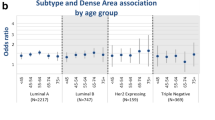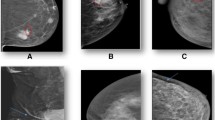Abstract
Purpose
Mammographic density (MD) is a strong risk factor for breast cancer, yet its relationship with tumor characteristics is not well established, particularly in Asian populations.
Methods
MD was assessed from a total of 2001 Chinese breast cancer patients using Breast Imaging Reporting and Data System (BI-RADS) categories. Molecular subtypes were defined using immunohistochemical status on ER, PR, HER2, and Ki-67, as well as tumor grade. Multinomial logistic regression was used to test associations between MD and molecular subtype (luminal A = reference) adjusting for age, body mass index (BMI), menopausal status, parity, and nodal status.
Results
The mean age at diagnosis was 51.7 years (SD = 10.7) and the average BMI was 24.7 kg/m2 (SD = 3.8). The distribution of BI-RADS categories was 7.4% A = almost entirely fat, 24.2% B = scattered fibroglandular dense, 49.4% C = heterogeneously dense, and 19.0% D = extremely dense. Compared to women with BI-RADS = A/B, women with BI-RADS = D were more likely to have HER2-enriched tumors (OR = 1.81, 95% CI 1.08–3.06, p = 0.03), regardless of menopausal status. The association was only observed in women with normal (< 25 kg/m2) BMI (OR = 2.43, 95% CI 1.24–4.76, p < 0.01), but not among overweight/obese women (OR: 0.98, 95% CI 0.38–2.52, p = 0.96).
Conclusions
Among Chinese women with normal BMI, higher breast density was associated with HER2-enriched tumors. The results may partially explain the higher proportion of HER2+ tumors previously reported in Asian women.
Similar content being viewed by others
Abbreviations
- MD:
-
Mammographic density
- ER+:
-
Estrogen receptor-positive
- ER−:
-
Estrogen receptor-negative
- PR+:
-
Progesterone receptor-positive
- PR−:
-
Progesterone receptor-negative
- CHCAMS:
-
Chinese Academy of Medical Sciences and Peking Union Medical College
- BI-RADS:
-
Breast Imaging Reporting and Data System
- IHC:
-
Immunohistochemical
- FISH:
-
Fluorescence in situ hybridization
- BMI:
-
Body mass index
- ANOVA:
-
Analysis of variance
- OR:
-
Odds ratio
- CI:
-
Confidence interval
- SD:
-
Standard deviation
- DAS:
-
Density analysis software
- SEER:
-
Surveillance, Epidemiology, and End Results
- TDLU:
-
Terminal duct lobular involution
References
Boyd NF, Guo H, Martin LJ et al (2007) Mammographic density and the risk and detection of breast cancer. N Engl J Med 356:227–236
McCormack VA, dos Santos Silva I (2006) Breast density and parenchymal patterns as markers of breast cancer risk: a meta-analysis. Cancer Epidemiol Prev Biomark 15:1159–1169
Yaghjyan L, Colditz GA, Collins LC et al (2011) Mammographic breast density and subsequent risk of breast cancer in postmenopausal women according to tumor characteristics. J Natl Cancer Inst 103(15):1179–1189. https://doi.org/10.1093/jnci/djr225
Eriksson L, Czene K, Rosenberg L et al (2012) The influence of mammographic density on breast tumor characteristics. Breast Cancer Res Treat 134:859–866. https://doi.org/10.1007/s10549-012-2127-0
Phipps AI, Buist DS, Malone KE et al (2012) Breast density, body mass index, and risk of tumor marker-defined subtypes of breast cancer. Ann Epidemiol 22:340–348
Eriksson L, Hall P, Czene K et al (2012) Mammographic density and molecular subtypes of breast cancer. Br J Cancer 107:18–23
Yang W-T, Dryden M, Broglio K et al (2008) Mammographic features of triple receptor-negative primary breast cancers in young premenopausal women. Breast Cancer Res Treat 111:405–410
Chen J-H, Hsu F-T, Shih H-N et al (2009) Does breast density show difference in patients with estrogen receptor-positive and estrogen receptor-negative breast cancer measured on MRI? Ann Oncol 20:1447–1449
Holm J, Eriksson L, Ploner A et al (2017) Assessment of breast cancer risk factors reveals subtype heterogeneity. Cancer Res 77:3708–3717. https://doi.org/10.1158/0008-5472.CAN-16-2574
Shin J, Lee JE, Ko HY et al (2018) Association between mammographic density and tumor marker-defined breast cancer subtypes: a case-control study. Eur J Cancer Prev 27:239–247. https://doi.org/10.1097/CEJ.0000000000000353
Antoni S, Sasco AJ, dos Santos Silva I, McCormack V (2013) Is mammographic density differentially associated with breast cancer according to receptor status? A meta-analysis. Breast Cancer Res Treat 137:337–347
Sartor H, Zackrisson S, Elebro K et al (2015) Mammographic density in relation to tumor biomarkers, molecular subtypes, and mode of detection in breast cancer. Cancer Causes Control 26:931–939. https://doi.org/10.1007/s10552-015-0576-6
Carey LA, Perou CM, Livasy CA et al (2006) Race, breast cancer subtypes, and survival in the Carolina Breast Cancer Study. JAMA 295:2492–2502
Clarke CA, Keegan THM, Yang J et al (2012) Age-specific incidence of breast cancer subtypes: understanding the black-white crossover. J Natl Cancer Inst 104:1094–1101. https://doi.org/10.1093/jnci/djs264
del Carmen MG, Halpern EF, Kopans DB et al (2007) Mammographic breast density and race. Am J Roentgenol 188:1147–1150
Rajaram N, Mariapun S, Eriksson M et al (2017) Differences in mammographic density between Asian and Caucasian populations: a comparative analysis. Breast Cancer Res Treat 161:353–362. https://doi.org/10.1007/s10549-016-4054-y
Nie K, Su M-Y, Chau M-K et al (2010) Age- and race-dependence of the fibroglandular breast density analyzed on 3D MRI. Med Phys 37:2770–2776. https://doi.org/10.1118/1.3426317
Sung H, Ren J, Li J et al (2018) Breast cancer risk factors and mammographic density among high-risk women in urban China. NPJ Breast Cancer 4:3. https://doi.org/10.1038/s41523-018-0055-9
Nazari SS, Mukherjee P (2018) An overview of mammographic density and its association with breast cancer. Breast Cancer 25:259–267. https://doi.org/10.1007/s12282-018-0857-5
Heller SL, Hudson S, Wilkinson LS (2015) Breast density across a regional screening population: effects of age, ethnicity and deprivation. Br J Radiol 88:20150242. https://doi.org/10.1259/bjr.20150242
Horne HN, Beena Devi CR, Sung H et al (2015) Greater absolute risk for all subtypes of breast cancer in the US than Malaysia. Breast Cancer Res Treat 149:285–291. https://doi.org/10.1007/s10549-014-3243-9
D’Orsi CJ, Sickles EA, Mendelson EB, Morris EA et al (2013) ACR BI-RADS® Atlas, Breast Imaging Reporting and Data System. American College of Radiology, Reston
Sisti JS, Collins LC, Beck AH et al (2016) Reproductive risk factors in relation to molecular subtypes of breast cancer: results from the nurses’ health studies. Int J Cancer 138:2346–2356. https://doi.org/10.1002/ijc.29968
Edwards BL, Atkins KA, Stukenborg GJ et al (2017) The association of mammographic density and molecular breast cancer subtype. Cancer Epidemiol Biomark Prev 26:1487–1492. https://doi.org/10.1158/1055-9965.EPI-16-0881
Vachon C, Tamimi R, Chen Y-Y et al (2016) Abstract IA22: mammographic density: a risk factor for all breast cancers or only specific subtypes? Cancer Epidemiol Prev Biomark 25:IA22. https://doi.org/10.1158/1538-7755.DISP15-IA22
Razzaghi H, Troester MA, Gierach GL et al (2013) Association between mammographic density and basal-like and luminal A breast cancer subtypes. Breast Cancer Res BCR 15:R76. https://doi.org/10.1186/bcr3470
Yaghjyan L, Tamimi RM, Bertrand KA et al (2017) Interaction of mammographic breast density with menopausal status and postmenopausal hormone use in relation to the risk of aggressive breast cancer subtypes. Breast Cancer Res Treat 165:421–431. https://doi.org/10.1007/s10549-017-4341-2
Krishnan K, Baglietto L, Stone J et al (2017) Mammographic density and risk of breast cancer by tumor characteristics: a case–control study. BMC Cancer 17:859. https://doi.org/10.1186/s12885-017-3871-7
Ji Y, Shao Z, Liu J et al (2018) The correlation between mammographic densities and molecular pathology in breast cancer. Cancer Biomark. https://doi.org/10.3233/CBM-181185
Neuhouser ML, Aragaki AK, Prentice RL et al (2015) Overweight, obesity, and postmenopausal invasive breast cancer risk: a secondary analysis of the women’s health initiative randomized clinical trials. JAMA Oncol 1:611–621. https://doi.org/10.1001/jamaoncol.2015.1546
Iyengar NM, Gucalp A, Dannenberg AJ, Hudis CA (2016) Obesity and cancer mechanisms: tumor microenvironment and inflammation. J Clin Oncol 34:4270–4276. https://doi.org/10.1200/JCO.2016.67.4283
Lengyel E, Makowski L, DiGiovanni J, Kolonin MG (2018) Cancer as a matter of fat: the crosstalk between adipose tissue and tumors. Trends Cancer 4:374–384. https://doi.org/10.1016/j.trecan.2018.03.004
Radenkovic S, Konjevic G, Gavrilovic D et al (2019) pSTAT3 expression associated with survival and mammographic density of breast cancer patients. Pathol Res Pract 215:366–372. https://doi.org/10.1016/j.prp.2018.12.023
Ginsburg OM, Martin LJ, Boyd NF (2008) Mammographic density, lobular involution, and risk of breast cancer. Br J Cancer 99:1369–1374. https://doi.org/10.1038/sj.bjc.6604635
Ghosh K, Hartmann LC, Reynolds C et al (2010) Association between mammographic density and age-related lobular involution of the breast. J Clin Oncol 28:2207–2212. https://doi.org/10.1200/JCO.2009.23.4120
Gierach GL, Patel DA, Pfeiffer RM et al (2016) Relationship of terminal duct lobular unit involution of the breast with area and volume mammographic densities. Cancer Prev Res 9:149–158. https://doi.org/10.1158/1940-6207.CAPR-15-0282
Ghosh K, Vierkant RA, Frank RD et al (2017) Association between mammographic breast density and histologic features of benign breast disease. Breast Cancer Res 19:134. https://doi.org/10.1186/s13058-017-0922-6
Sherratt MJ, McConnell JC, Streuli CH (2016) Raised mammographic density: causative mechanisms and biological consequences. Breast Cancer Res 18:45. https://doi.org/10.1186/s13058-016-0701-9
Sawada Y, Tamada M, Dubin-Thaler BJ et al (2006) Force sensing by mechanical extension of the Src family kinase substrate p130Cas. Cell 127:1015–1026. https://doi.org/10.1016/j.cell.2006.09.044
Mouw JK, Yui Y, Damiano L et al (2014) Tissue mechanics modulate microRNA-dependent PTEN expression to regulate malignant progression. Nat Med 20:360–367. https://doi.org/10.1038/nm.3497
Triulzi T, Forte L, Regondi V et al (2019) HER2 signaling regulates the tumor immune microenvironment and trastuzumab efficacy. Oncoimmunology 8:e1512942. https://doi.org/10.1080/2162402X.2018.1512942
Huo CW, Hill P, Chew G et al (2018) High mammographic density in women is associated with protumor inflammation. Breast Cancer Res 20:92. https://doi.org/10.1186/s13058-018-1010-2
Sun X, Gierach GL, Sandhu R et al (2013) Relationship of mammographic density and gene expression: analysis of normal breast tissue surrounding breast cancer. Clin Cancer Res 19:4972–4982. https://doi.org/10.1158/1078-0432.CCR-13-0029
Gabrielson M, Chiesa F, Paulsson J et al (2016) Amount of stroma is associated with mammographic density and stromal expression of oestrogen receptor in normal breast tissues. Breast Cancer Res Treat 158:253–261. https://doi.org/10.1007/s10549-016-3877-x
Fasching PA, Heusinger K, Loehberg CR et al (2006) Influence of mammographic density on the diagnostic accuracy of tumor size assessment and association with breast cancer tumor characteristics. Eur J Radiol 60:398–404. https://doi.org/10.1016/j.ejrad.2006.08.002
Lee HN, Sohn Y-M, Han KH (2015) Comparison of mammographic density estimation by Volpara software with radiologists’ visual assessment: analysis of clinical-radiologic factors affecting discrepancy between them. Acta Radiol 56:1061–1068. https://doi.org/10.1177/0284185114554674
Singh T, Sharma M, Singla V, Khandelwal N (2016) Breast density estimation with fully automated volumetric method: comparison to radiologists’ assessment by BI-RADS categories. Acad Radiol 23:78–83. https://doi.org/10.1016/j.acra.2015.09.012
Acknowledgement
This work was supported by the Intramural Research Program of the National Institutes of Health, National Cancer Institute, Division of Cancer Epidemiology and Genetics.
Author information
Authors and Affiliations
Corresponding authors
Ethics declarations
Conflict of interest
The authors have no conflicts of interest to disclose.
Additional information
Publisher's Note
Springer Nature remains neutral with regard to jurisdictional claims in published maps and institutional affiliations.
Electronic supplementary material
Below is the link to the electronic supplementary material.
Rights and permissions
About this article
Cite this article
Li, E., Guida, J.L., Tian, Y. et al. Associations between mammographic density and tumor characteristics in Chinese women with breast cancer. Breast Cancer Res Treat 177, 527–536 (2019). https://doi.org/10.1007/s10549-019-05325-6
Received:
Accepted:
Published:
Issue Date:
DOI: https://doi.org/10.1007/s10549-019-05325-6




